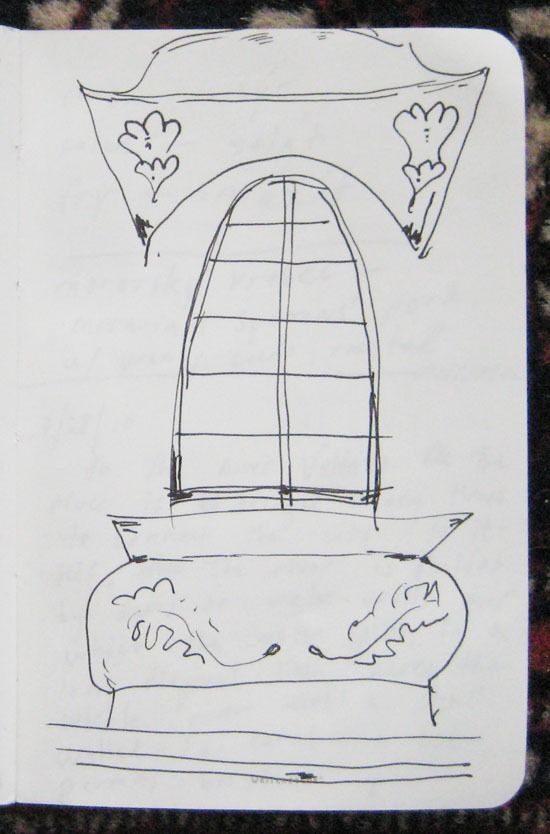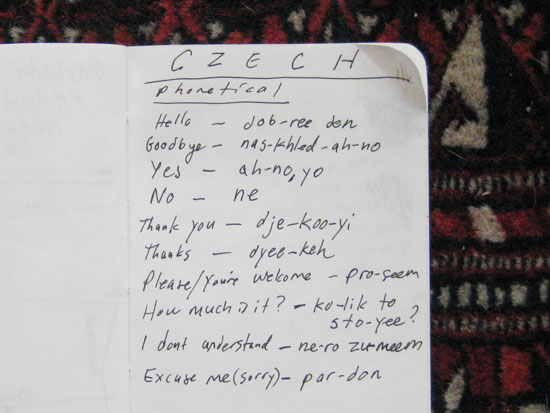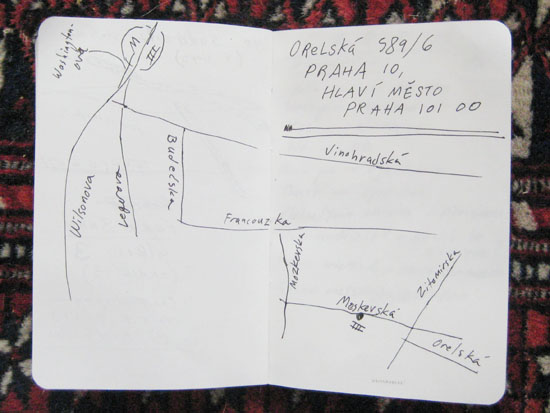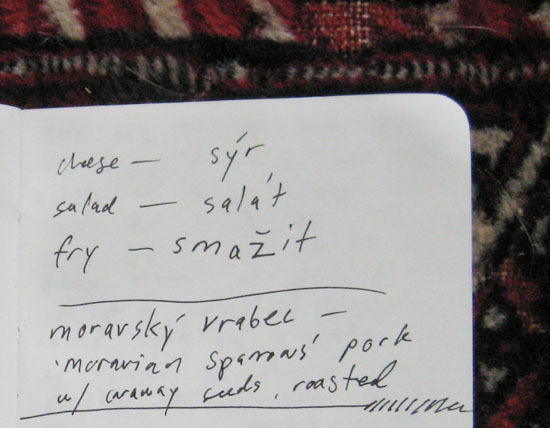More notes from my recent trip to Central Europe. I kept them in a book in my pocket and typed them up after getting home.
7/23/10 – h
On the train from Berlin to Prague. East German countryside passing by, long flat wheat fields, patches of thin, new-growth woods with creeks and small lakes, rivers. The sky is thick gray, a summer storm brought heavy rain, big warm drops of it, last night in the hot humid air, and there were lightning flashes and rolling thunder over Berlin. I’m surprised at how tropical the weather in Central Europe feels in the summer. The balmy day with intervals of warm rain is like Mexico City in the springtime.
The countryside we’re passing feels deeply agricultural. We’re passing through Roderau. Old houses with short fences, two and three story with roofs pitched from all 4 sides then up to a flat part and then the final pitch with protruding attic alcoves. Walls with flaking paint uncovering old stucco over older brick, or weathered stone. Little brick stations with names on them painted in black on white in German script, not blackletter but definitely calligraphy.
It is classic European countryside as I have seen in films and imagined. Wet, green, lush, agricultural. It’s more like the California foothills, with smaller plots and interspersed houses, than the real farming land of California with its giant agricultural fields and machine-planted rows. It’s idyllic, iconic. To my American eyes, it’s also familiar, with a similar sensibility to settlements in the American countryside.
Yet there are distinct differences – as I pass by on the train, the houses do look on average taller, less horizontal, and certainly older. There’s a marked absence of cookie-cutter developments on a mass scale; when I see identical houses they’re in a small row. Bold graffiti slides across railside buildings in their decline. Green space exists right up against compact development.
*
Passing into Czech Republic. Smokestacks, swaybacked warehouses, broad brown river, long deep green hills. Towns with concrete slab-style buildings next to ornate 5-story houses with moldings on the windows and embellishments. Sleek modern bridges, then old steel hulks of rusting train crossings. Sharp church spires, needlelike, steam rising.

Prague.
High-flying ancient buildings blackened by time and diesel. New scrubbed tourists thronging the medieval square, the sheer mass of them creating a theme-park effect in the absurdly ornate, beautiful and intact historic square. The buildings crowd in on narrow cobbled streets, where tourists in sports clothing squeeze into trinket shops filled with cheap plastic stuff, the odd marionette shop, “Bohemian Crystal” and restaurants selling “authentic Czech cuisines.”
The place is choking on its authenticity.
Outside the tourist zone, there is a vaguely depressed air, something of the Soviet era hanging still. In Hybernia Restaurant we sit in a cobblestone courtyard at a table under one of the ubiquitous Pilsner Urquell umbrellas. The building above us is off-white with white trim, jutting out where the floors are marked, jigsawing around the windows.
At a table in the corner there is a little scene of Slav mafioso types, either real or trying to look that way. A couple older guys in suits with flashy watches smoke and hold forth. The fat one with the tan keeps flagging the waitresses down. Next to him is a young fool in a white polo with the collar turned up, a shaved head and wraparound sunglasses. The bunch sit and pose like royalty, and when they leave, the restaurant manager graciously shakes the fat gangster’s hand while the waitress rolls her eyes.

7/24/10 – h
In Klub Ujezd in a neighborhood across the river Voltava, with a much different feel. I’m having an absinthe… the Czech Republic is one of the few places in the world where the green, wormwood-infused liquor is legal. You don’t get the whole slotted spoon treatment of Paris legend. The bartender served it to me in a shot glass. I asked how people consume it, and the bartender turned to the guy he was playing dice with, talked in Czech for a moment, then said people pour sugar into a spoon, hold a flame over it to carmelize the sugar, and then mix it with the absinthe.
I finished my shot, and I can’t tell yet if it feels any different from a regular shot of strong alcohol. I do seem to feel an unusual sense of calm and clarity. There’s music going, and it does seem to be right in my ears sort of in the way it can be on a really clean pot buzz. One thing just occurred to me – this cigarette I’ve been smoking seems to have lasted a very long time. I can’t tell if it’s just the force of my imagination, but the longer I feel it, the more it seems there is something different about absinthe.
7/25/10 – h
In the tower of St. Vitus Cathedral in the Prague Castle. The view is astounding. The castle – which is a whole complex of buildings and palaces – is laid out at your feet and all of Prague surrounds it, unfolding in green, white, and red: gardens and parks, buildings and red roofs.
*
Headed back to the apartment on the 22 tram. Exhausted by the crush of tourists in which we pressed half the day at the castle and around, in the old Jewish Quarter. My phrasebook is useless – not only is the Czech language difficult, hypersyllabic and unpronounceable, but the velvet curtain between Czechs and tourists here is hard as iron, soft but impenetrable. Unlike in Latin America, where people will help you as you fake it with a smile and a nod to indicate if you’ve got it right, even offering a hint or an impromptu language lesson, here they are cold and unresponsive. Not only that, but observing other people’s interactions is less helpful, since the whole manner is different. More subdued, less formally polite. It is less obvious what Czechs are saying to each other and thus to learn by observation.
7/26/10 – h
Navigating the transit system in Prague is tricky. There are 2 tram systems: streetcars and an underground subway. The navigation system is text rather than icon driven, and this design presents obvious problems if you don’t speak the language. That said, the connections are fast and the trains run late and often. The stations, while not the works of art that the Berlin stations are, are interesting: the subway tunnels plated with colored metal with a dull gleam, large plates with round protrusions like inverted bowls, which gives the tunnel the look of the inside of a long beaded bracelet.
*
In Prague I’ve seen more begging and hustling than in Berlin. A man asked me for money on the tram. I gave him 20 crowns – a dollar – and he seemed pretty happy, smiling wide to reveal his few remaining teeth. There are canvassers and salespeople on the sidewalk and in the tram stations. A woman selling magazines.

7/28/10 – h
On the River Voltava. The river is bridged many times to connect the city to itself. The river is divided by dams or water-walls over which the water spills, in a long diagonal line across the whole river until a small walled-in canal – a lock – permits boats to pass up and down the river.
We are in the lock now. It takes a while, but it’s worth it to go through the lock and south, to an area below the Charles Bridge, where one gets a view of a castle in Prague called Vyshrad. While not as massive as Prague’s main castle, it looks more like the castle of European myth, perched on a cliff over water, ancient stone turrets and cathedral spires.
The cathedrals have sharply angular spires here. It seems to be a signature of Slavic architecture. It reminds me of the Mormon’s grand temple in Salt Lake City. I wonder what caused the Mormons to adopt this particular architectural motif, of all the ones available in Europe’s and America’s sacred architecture.
The trams ride up and down the stone wall of the riverbank. Modern midsize cruise boats line the banks, angular lines and low windows, sharp prows, white hulls, green or red trim bright in the patchy sun, curtains in the windows, dark interiors, orange lifesavers, vinyl awnings on the decks, flapping in the wind, ads on the awnings for Pepsi, aquasys.cz, etc. and on the boats flags flying: Czech flags blue white and red and EU flags, blue with a thin crown of yellow stars.

This morning we had some great food. The trick is going to a real Czech restaurant with no English menu and puzzling through with your phrasebook. Yukio and I had goulash, Czech dumplings, and beer, Anya the fried cheese and french fries, Aurora a chicken salad. The goulash was dark and rich, peppery.
7/29/10 – h
Our last night in Prague was great. We went to a bar in Zizkov called Bukowski, named after the American writer. A dark candlelit dive with a fantastic cocktail menu. Came across a little outpost Vice Magazine has in Prague, a small shop selling magazines, beer and cigarettes, and picked up a free booklet, “The Vice Guide to Prague.” The usual mix of good info and smut, would have been great if I had found it on the first day, there are some interesting spots particularly art galleries listed in it. We didn’t see any galleries, though we were looking for them just walking around, trying to find an arts district Yukio read about in the New York Times.
Prague is amazing, but the touristed zones are hard to enjoy due to being heavily overrun. I feel like the real Prague is sort of hidden, would take some further digging to get to.
Glad to be back in Germany. We’re now in Dresden, on the train heading into the city.
More notes coming on last days in Germany before coming back to California.